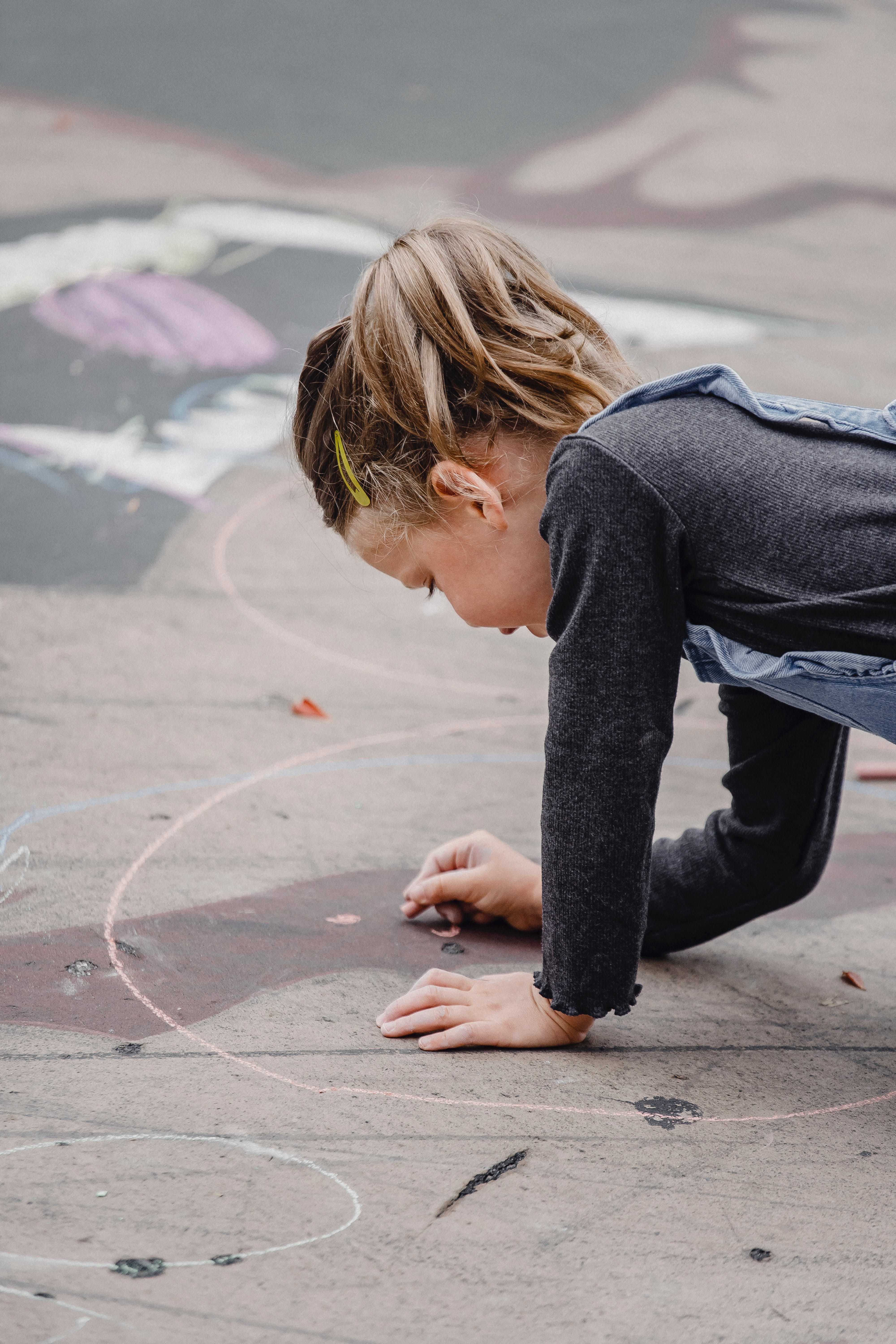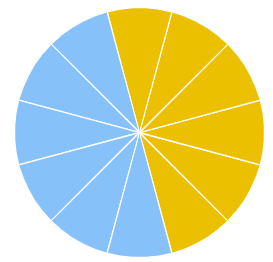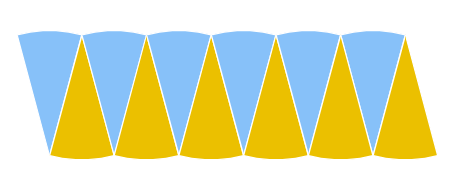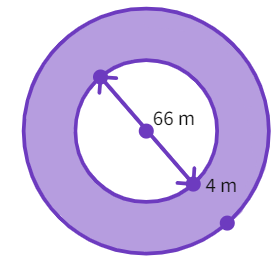Area of Circle
In the earlier section, we spoke about putting ribbons along the border of circular cardboard cutouts. Say, we need to colour the cutouts using crayons. How many crayons will be required? How much time will it take to do this task? This is all concerned with the amount of area that needs to be coloured.

In other real-life scenarios:
Say, a gardener needs to fertilise a circular flower bed of radius 7 m. If 1 kg of fertiliser is required for 1 square metre area, how much fertiliser he needs to purchase?
We need to polish a circular table-top of radius 2 m, with the cost of polishing being Rs. 10 per square metre. How much money do we need to get the work done?
To find the area of a circle, let us do an activity.
Here you can see a circle divided into ${toWord(n1)} wedges. Move the slider, to line up the wedges in one row.
If we increase the number of wedges to
Activity: Draw a circle and shade one half of the circle with any colour. Now fold the circle and divide the circle into a total of eight parts. Once this is done, cut along the folds.


Now, arrange the eight separate sections as shown above. We see that the sections together form (roughly) a
As the more sectors that we make increases, the nearer we reach to an appropriate rectangle (which is, as we know, a type of parallelogram), upon arranging the sections together in a straight line.
Now, what can be said about the breadth of this rectangle that is being formed?
From the figures, we can deduce that the breadth of the rectangle is equal to the
Say, we divide the entire circle into 64 equal sectors. On doing so, we will get, on each side, 32 sectors. Thus, the length of the formed rectangle is equal to the length of the 32 sectors i.e. the length is
Therefore,
Area of the circle = Area of rectangle thus formed
= l × b
= (Half of circumference) × radius
= x (2πr) x r
= πr2
Thus,
Area of the circle = πr2
Let's Solve
- The adjoining figure shows two circles with the same centre
- The radius of the larger circle = 10 cm
- The radius of the smaller circle = 4 cm.
- π = 3.14

Find: (assume value of π to be 3.14)
(a) the area of the larger circle
(b) the area of the smaller circle
(c) the shaded area between the two circles
- Since, the radius of the larger circle is 10 cm, the area of the circle is
cm 2 - Calculating
- Finding area of smaller circle with radius 4 cm, we get
cm 2 - Calculating
- The shaded area is represented by the
of the two calculated areas. - The difference between the two areas =
- Thus, the shaded area is 263.76
cm 2
- Say, we have a field similar to the area in the previous question. Now, a gardener wants to fence the shaded region (as in the previous figure). What is the length and cost of the rope needed for fencing?
Additional Information:
Rope needs to make 2 rounds of fence
Cost = Rs 4 per meter and π =
Note: Take the numerical values from previous question but in meters.
- Fro calculation of rope length, we need to find the
of the field. - The total perimeter will be
of the two perimeters. - Perimeter of larger circle =
π - Perimeter of smaller circle =
π - Total Perimeter = 28π =
m. - Since, we need to make 2 rounds of the fence, the length of rope required is
m. - Since, the cost of the rope per m is Rs.4, the cost of the rope is Rs.
- Cost of the rope is Rs.704
- If the circumference of a circular sheet is 154 m, find its radius. Also find the area of the sheet. (Take π = )
- Since, we know the circumference, we can find the radius using the formula: circumference =
- Putting the values,
= r ,where r is the radius. - Thus, r =
m - Now, using this value to get the area of the sheet.
- Area of sheet =
m 2 - Thus, we have found the required values.
- Saima wants to put a lace on the edge of a circular table cover of diameter 1.5 m. Find the length of the lace required and also find its cost if one meter of the lace costs Rs.15
(Take π = 3.14)
- Since, we know the diameter, we can find the circumference as cicumference =
where d is the diameter. - Thus, circumference of table =
m - Since, the lace cost is Rs.15 per m, the cost of the lace required is Rs.
- Thus, we have found the cost to be Rs. 70.65
Shazli took a wire of length 44 cm and bent it into the shape of a circle.
(a) Find the radius of the circle
(b) Find the area of the circle
(c) If the same wire is bent into the shape of a square, find the length of each of side.
(d) Which figure encloses more area, the circle or the square?
(Take π = )
- We have the
of the circle as 44 cm. - Using the circumference formula to find the radius
- Thus, the radius is found to be
cm - Finding the area of the circle, we get
cm 2 - Taking the same wire, we make a square.
- The length of the side for this square is
cm - Thus, the area of the square is
cm 2 - On comparison, the
has the larger area.
- Sarita wants to make a mask and uses a circular card sheet of radius 14 cm. For provision of sight and speech respectively, she makes two circles of radius 3.5 cm and a rectangle of length 3 cm and breadth 1cm and cuts them off. Find the area of the mask.
(Take π = )

- The area of the circular sheet =
cm 2 - Now, finding area of the two smaller circles
- Total area of the two small circles is
cm 2 - Finding the area of the rectangular mouth, we get
cm 2 - Thus, calculating the area of the mask
cm 2 - The area of the mask is found to be 536
cm 2
- A circular flower bed is surrounded by a path 4 m wide. The diameter of the flower bed is 66 m. What is the area of this path? (Round off to one decimal place and π = 3.14)

- Radius of flower bed =
m - Now, Area of flower bed =
m 2 - The radius of the flower bed and path together is
m - Finding the area of the flower bed and path, we get
m 2 - Thus, calculating the area of the path
m 2 - The area of the path is found to be 879.2
m 2
- A circular flower garden has an area of 314 m2. A sprinkler at the centre of the garden can cover an area that has a radius of 12 m. Will the sprinkler water the entire garden?
(Take π = 3.14)
- To check we need to calculate the
of the circular garden - Knowing the garden area, we find that the radius is
m. - Since, the sprinker can cover a radius of 12m, it
water the garden. - Thus, the garden can be watered by the sprinkler
- How many times a wheel of radius 28 cm must rotate to go 352 m? (Take π = )
- To check rotations, we need to calculate the
of the wheel. - Substituting
- Calculating we get
cm - Wheel circumference = 176 cm
- To calculate the rotations
- We can write:
= x n (n - number of rotations) - Substituting
- Thus, n(number of rotations) =
- Substituting
- Thus, the number of rotations to cover the given distance is equal to 200.
- The minute hand of a circular clock is 15 cm long. How far does the tip of the minute hand move in 1 hour. (Take π = 3.14)
- For distance covered, we need to calculate the
of the cicular path made by the clock hand. - Substituting
- Calculating we get
cm - Circumference for one rotation = 94.2 cm
- Number of rotations made by the minute hand is one hour =
- Substituting
- Thus, distance covered by minute hand in one hour is 94.2 cm.
